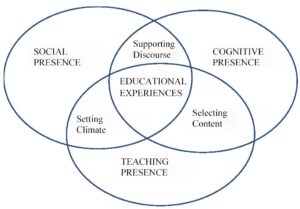
Community of Learning
Garrison, Anderson and Archer (2000) presented the online teaching model as a Community of Inquiry with three main elements: Teaching presence, social presence and cognitive presence.
 Community of Inquiry by Garrison, Anderson, and Archer (2000, p. 2)
Community of Inquiry by Garrison, Anderson, and Archer (2000, p. 2)
Teaching presence is the responsibility of the teachers to select, organise materials, design the course to encourage students to interact while social presence refers is to show as a real person in the community. Cognitive presence refers to the construction of meaning by students through participating in the course. Garrison, Anderson, and Archer (2000) stated there was a correlation between these three types of presence. Since then, many studies have been conducted to examine the relationship among these three elements. Students gave a higher rate of the overall quality of interaction when instructors gave immediate feedback which means that course instructors were highly evaluated when they showed more teaching presence in an online course (Khalid & Quick, 2016; Richardson & Swan, 2003). Teaching presence was reported to be correlated with social presence because when teachers showed more teaching presence, students showed more social presence (Kanuka & Garrison, 2004; Shea & Bidjerano, 2009) and social presence was reported to correlate with learning outcomes (Hostetter & Busch, 2013; Romanov & Nevgi, 2008). These students concluded that students who participated more in the course, their learning outcomes were better than those who did not. In short, teaching presence affects social presence, or the better teaching presence is, the more social presence students will show. When students show more social presence, it will result in a better learning outcome. Therefore, the main responsibility of an online teacher is to organise the course so that students could show more social presence by joining online discussions, engaging in reading more materials. This essay will brainstorm some techniques to organise your teaching presence to improve social presence, which might result in a better cognitive presence or learning outcome.
The online teacher can engage students to do activities synchronously and asynchronously. Here are some techniques to enable students to interact asynchronously in an online course. To engage students to interact synchronously, some learning platforms such as Schoology, Edmodo or Google Classroom should be used. There are three main types of interactions: students’ interaction with materials, interaction among students, students and instructor interaction.
First, to encourage students to read materials, and watch a movie that the teacher should design a quiz to check whether students watch and understand the materials or not. This stage enables students to try to understand the materials. However, the quiz should include in the final assessment so that students will try their best to do it. By doing this step, students will interact with materials and show more social presence in the online course.
Second, after students understand the materials, they should be asked to interact with each other to share their understanding of the materials. At this step, some questions should be posted for students to share their opinions. To encourage students to interact with other students, students should be asked to reply at least two students’ posts. By doing this way, students will read other students’ posts and reply to other people post. The online forum is very important because students could reflect their ideas and show their deep understanding of the lesson.
Finally, the teacher could interact with students through an online learning platform. For example, the teacher could comment on students’ posts or give them some written feedback. If the teacher could give students some oral feedback, he could make a video by using Camtasia to upload on the learning platform.
Similarly, the teacher could interact with students synchronously. Synchronous interactions should also have three different types of interactions as described in the synchronous process. The interaction could happen through Zoom, Google Classroom or Skype. When the teacher gives students some materials, he should set up some activities for students so that they could show their understandings. Also, the teacher could create similar interactions such as group discussions for students such as Zoom breakout. Of course, during the online meeting, the teacher could have direct interactions with students.
These techniques are for online teaching; however, these also could apply in physical classes after COVID-19. The model for this kind of teaching is blended learning. The teacher could send students materials such as reading materials or videos that the teacher prepares in advance. However, to make sure that students watch the videos or read the materials, some tasks such as quizzes, questions or gap filling should be set up and these tasks should be a part of the final assessment to motivate students to complete all the tasks. These activities could be conducted online. Discussions could be carried in class when teacher and students see each other. The teacher can have more time for feedback and explore the lessons further.
In conclusion, the responsibility of the online teacher is to design the activities to encourage students to improve their interactions with materials, other students and teachers so that students could show more social presence which results in better learning outcomes.
Thinh Le Van holds a PhD degree from the University of Canterbury, New Zealand. He is an English lecturer at Banking Academy, Vietnam. His research interest is around language, learning with a focus on computer-assisted language learning (CALL). Email: lethinhpy@yahoo.com
References
Garrison, D. R., Anderson, T., & Archer, W. (2000). Critical inquiry in a text-based environment: Computer conferencing in higher education. The Internet and Higher Education, 2(2), 87-105.
Hostetter, C., & Busch, M. (2013). Community matters: Social presence and learning outcomes. Journal of the Scholarship of Teaching and Learning, 13(1), 77-86.
Kanuka, H., & Garrison, D. R. (2004). Cognitive presence in online learning. Journal of Computing in Higher Education, 15(2), 1-19.
Khalid, M. N., & Quick, D. (2016). Teaching presence influencing online students’ course satisfaction at an institution of higher education. International Education Studies, 9(3), 62-70.
Richardson, J., & Swan, K. (2003). Examing social presence in online courses in relation to students’ perceived learning and satisfaction. Journal of Asynchronous Language Networks, 7(1), 68-88.
Romanov, K., & Nevgi, A. (2008). Student activity and learning outcomes in a virtual learning environment. Learning Environments Research, 11(2), 153-162.
Shea, P., & Bidjerano, T. (2009). Community of inquiry as a theoretical framework to foster “epistemic engagement” and “cognitive presence” in online education. Computers & Education, 52(3), 543-553.
Cite as: Le Van, T. (2020). Techniques of online teaching. https://eltchoutari.com/2020/07/techniques-of-online-teaching/